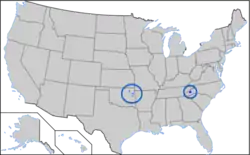Cherokee
The Cherokee (Cherokee: ᎠᏂᏴᏫᏯᎢ, romanized: Aniyvwiyaʔi or Anigiduwagi) are Native Americans who at the time of European contact in the 16th century lived in the area that is now called the eastern and southeastern United States before most were forcefully moved to the Ozark hills. They were one of the tribes referred to as the Five Civilized Tribes.
Cherokee Nation ᎠᏂᏴᏫᏯᎢ | |||||||||
|---|---|---|---|---|---|---|---|---|---|
 Flag | |||||||||
 | |||||||||
| Capital | Tahlequah, Oklahoma | ||||||||
| Official languages | Cherokee language | ||||||||
| Demonym(s) | Cherokee | ||||||||
| Government | Tribe Indian reservation | ||||||||
| History | |||||||||
• Established | c. 1500 | ||||||||
| |||||||||
| Today part of | United States | ||||||||
Cherokee people did not live in tepees. They lived in houses made from wood. In the 19th century, a man named Sequoyah introduced a form of writing the Cherokee language. For this, he was awarded a medal.

The Cherokee tribe had two chiefs, a red and white chief. When the tribe was at war, the red chief would lead, and when there was peace within the tribe, the white chief would lead.[1] Chief John Ross was the leader of the Cherokee tribe from 1818 until 1867. He lived in Georgia before being forced to move to the place now called Oklahoma.
There are three Cherokee tribes recognized by the U.S. government:[2][3]
- Cherokee Nation in Oklahoma.
- United Keetoowah Band of Cherokee Indians in Oklahoma.
- Eastern Band of Cherokee Indians in North Carolina.
References
- Crawford O'Brien, Suzanne (2005). American Indian religious traditions : an encyclopedia. Dennis F. Kelley. Santa Barbara, Calif. pp. 69–72. ISBN 1-57607-520-6. OCLC 61367206.
{{cite book}}: CS1 maint: location missing publisher (link) - Indians.org
- National Conference of State Legislators

